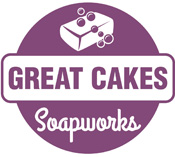Mixing Soap Colorants
There are three different ways (that I know of) to mix soap colorants. One is with water (which only works with water-soluble colors such as FD&C, most micas, clays, and water-soluble titanium dioxide). The second way is with vegetable glycerin, which seems to work best with micas or pigments/oxides. And the third way is with oils, which will also work best with micas, pigments, oxides, and other natural colorants such as powdered herbs and cocoa powder.
So which method is the BEST method? I’ve attempted all of these, and no matter which one I’ve tried, if I am adding water, glycerin or oil to my soap recipe, it can alter the final soap. Add extra water and the soap can be sticky coming out of the mold. Add extra glycerin and the soap may never fully harden. Add extra oils and you may have the same problem – extra superfatting which can make the soap too soft.
The best solution I’ve come up with (whenever possible), is to use part of the oils from the soap recipe so that I’m not adding extra oils. This works very well with micas, pigments, oxides, and powdered herbs. The only downside to mixing soap colorants with oil is the clean-up. You have to use plenty of soap to wash up your containers, unless you are using something disposable.
What if the colorant is water-soluble? Most of the water-soluble colorants really don’t require that much water to disperse them. Especially the FD&C colors – a little goes a LONG way! Water-soluble titanium dioxide can be added to the lye water (I like to add it after the lye has heated up) to lighten an entire batch without adding any extra liquid. Even if I am only adding titanium dioxide to part of a batch, it doesn’t take more than a few tablespoons of water to dissolve it. Even clays and activated charcoal can be dispersed in water. The only time I had issues with sticky soap was when I tried to add water to micas because it took a lot more water than other colorants.
I used to LOVE using glycerin with micas and oxides because it was so easy to clean up afterwards. No soap required! That was before I ended up with a soft soap. I couldn’t figure out why it was taking so long for the Caribbean Diva soap to cure, compared to the Tahitian Vanilla. I had made them the same week! Until I remembered how much glycerin I had to use to disperse the orange mica in the Diva soap. It did eventually get hard enough to sell, and thankfully its size makes up for the fact that it’s a little bit softer than my other soaps, but I won’t make that mistake again.

I’d love to hear about others’ experiences and preferences!
Follow-up post on the subject is found here.
Page with Comments
Comments are closed.

Hi Amy,
I always use the soap oils from my batch, and I use pyrex glass container, to mix so I haven’t found that clean up was to bad. Plastic is a little harder to clean. Anyway, that is how I do it. Your soaps look great, especially the orange and white one!
I mix my micas with oil but I keep in mind that it’s going to add extra oil to the batch. So I will pull some out from my batch or lower my SF a bit if I know I’m adding lots of color. See my problem is thatI like to mix my colors up and mix extra, in case I don’t get the color I want, so I can’t really take that from my batch if I’m not going to be using it all up. I love water for my UM’s but at least it doesn’t take much at all. I’ve never used glycerin to mix my colors. I think I heard that it speeds trace but I can’t guarantee that!
Great tips! Thanks!
After trying the other ways I now just take a little bit of my soap and mix in the color then dump that into my soap and mix it in. More clean up but it works.
The orange and white soap is gorgeous! (Even it is was a little soft). Did you use a dowel and pull upward to get the white and orange to swirl in together? Love the effect!
Jennifer
I use water almost exclusively with my oxides and UMs, and then only about a teaspoon. Most of the ones I use work just fine. It’s worth trying each colorant in water just to see. Only one or two really need oil, and then I use some of my oils before adding the lye. A bit of soap, like Jennifer suggested also works great, but I like to have everything ready to go before I mix my lye and oils. I cheat with micas: I use Pop micas almost exclusively, and they blend in so easily, I just dump them dry into the soap batch and stick blend a little.
I mix all of my colours (clays, TD, micas, oxides, ultramaraines) with a little water.
I love using water soluble pigment b/c it relates well with water,prevents cloth stains.
I prefer water soluble to oil in soap making.